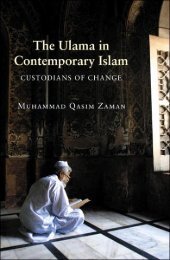The Qur'an in its historical context (pdf - Islam and Christian-Muslim ...
The Qur'an in its historical context (pdf - Islam and Christian-Muslim ...
The Qur'an in its historical context (pdf - Islam and Christian-Muslim ...
Create successful ePaper yourself
Turn your PDF publications into a flip-book with our unique Google optimized e-Paper software.
CLAUDE GILLIOT<br />
55 Gilliot, Exégèse, langue et théologie, 196–7; idem, “Le Coran, fruit d’un travail<br />
collectif?” 213ff.; J. Burton, “L<strong>in</strong>guistics errors <strong>in</strong> the Qur’an,” JSS 33, 1988, 181–96,<br />
accord<strong>in</strong>g to Abu ‘Ubayd.<br />
56 For these two issues, see Gilliot, “Collecte ou mémorisation du Coran. Essai<br />
d’analyse d’un vocabulaire ambigu,” a paper presented at the Eighth Colloquium<br />
From Jahiliyya to <strong>Islam</strong>, Jerusalem, July 2000, to be published <strong>in</strong> JSAI; idem, “Les<br />
traditions sur la composition ou coord<strong>in</strong>ation du Coran (ta’lif al-qur’an),” <strong>in</strong><br />
Cl. Gilliot und T. Nagel (eds), Das Prophetenhadit. Dimensionen e<strong>in</strong>er islamischen<br />
Literaturgattung, Gött<strong>in</strong>gen: V<strong>and</strong>enhoeck & Ruprecht, 2005, 14–39.<br />
57 See Gilliot, “Un verset manquant du Coran ou réputé tel,” <strong>in</strong> M.T. Urvoy (ed.), En<br />
hommage au Père Jacques Jomier, O.P., Paris: Cerf, 2002, 73–100; idem, “Le Coran,<br />
fruit d’un travail collectif?” 199–204.<br />
58 al-Jawaliqi, al-Mu‘arrab m<strong>in</strong> al-kalam al-a‘jami ‘ala huruf al-mu‘jam, Ahmad<br />
Muhammad Shakir (ed.), Cairo: Dar al-Kutub al-Misriyya, 1942; Suyuti, al-Itqan fi<br />
‘ulum al-Qur’an, Muhammad Abu l-Fadl Ibrahim (ed.), 2nd. revised edn, Cairo:<br />
al-Hay’a al-Misriyya al-‘Amma li-l-Kitab, 1974–5 (1st edn 1967), chapter 38, 2,<br />
125–43; W.Y. Bell, <strong>The</strong> Mutawakkili of as-Suyuti, a translation of the Arabic text, with<br />
<strong>in</strong>troduction, notes, <strong>and</strong> <strong>in</strong>dices, Dissertation Yale University, 1924; A. Sprenger,<br />
“Foreign words occurr<strong>in</strong>g <strong>in</strong> the Qôran,” Journal of the Asiatic Society of Bengal 21,<br />
1852, 109–14. R. Dvorˇák, E<strong>in</strong> Beitrag zur Frage über die Fremdwörter im Koran,<br />
Inaugural dissertation, München, 1884 (above all on tannur); FV; Hebbo, Die<br />
Fremdwörter <strong>in</strong> der arabischen Prophetenbiographie des Ibn Hischam (gest.<br />
218/834); Cl. Gilliot, Exégèse, langue et théologie, 95–110; A. Ripp<strong>in</strong>, “Foreign<br />
vocabulary,” EQ, 2, 226–37.<br />
59 J. Horovitz, “Jewish proper names <strong>and</strong> derivatives <strong>in</strong> the Koran,” Hebrew College<br />
Annual, 2, 1925, 145–227 (repr<strong>in</strong>t, Hildesheim: Olms, 1964); idem, Koranische<br />
Untersuchungen, Berl<strong>in</strong> <strong>and</strong> Leipzig: de Gruyter, 1926, 156–65.<br />
60 GdQ1, 31–4; FV, 233–4; Hebbo, Die Fremdwörter <strong>in</strong> der arabischen<br />
Prophetenbiographie des Ibn Hischam (gest. 218/834), 286–91; Luxenberg, Die<br />
syro-aramäische Lesart des Koran, 54–60 (2nd edn, 81–7)<br />
61 GdQ2, 11; Suyuti, al-Itqan fi ‘ulum al-Qur’an, chapter 18, 1, 205. For more details,<br />
see Gilliot, “Reconstruction,” § no. 15.<br />
62 For the Ethiopian orig<strong>in</strong> of mushaf (also: mashaf <strong>and</strong> mishaf), see Fraenkel, Die<br />
aramäischen Fremdwörter im Arabischen, 248; Hebbo, Die Fremdwörter <strong>in</strong> der<br />
arabischen Prophetenbiographie des Ibn Hischam (gest. 218/834), 228–30.<br />
63 Fraenkel, Die aramäischen Fremdwörter im Arabischen, 237–8; FV, 180–2; Hebbo,<br />
Die Fremdwörter <strong>in</strong> der arabischen Prophetenbiographie des Ibn Hischam (gest.<br />
218/834), 208–10.<br />
64 FV, 72–3. For other words see A.-L. de Prémare, “Textes musulmans,” 400–6.<br />
65 Wansbrough, Quranic Studies: Sources <strong>and</strong> Methods of Scriptural Interpretation,<br />
98–9 (for the exegetes); Larcher, “Language, concept of,” EQ, 3, 109 (for the<br />
l<strong>in</strong>guistic theorization of the exegetical debate); Gilliot <strong>and</strong> Larcher, “Language <strong>and</strong><br />
style,” 114.<br />
66 See Gilliot, Exégèse langue et théologie, chapters 3–4, 73–110.<br />
67 H.L. Fleischer, “Ueber arabische Lexicographie und Ta’âlibi’s Fiüh al-lu∫a,” <strong>in</strong><br />
Berichten für die Verh<strong>and</strong>lungen der k. sächs. Gesellschaft der W., Philol.-histor. Cl.,<br />
1854, 1–14, p. 5; repr<strong>in</strong>t <strong>in</strong> Kle<strong>in</strong>ere Schriften 3, Osnabrück 1964, 152–66, p. 156.<br />
68 Gilliot <strong>and</strong> Larcher, “Language <strong>and</strong> style,” 122.<br />
69 Gilliot <strong>and</strong> Larcher, “Language <strong>and</strong> style,” 109–24; Pierre Larcher, “Language,<br />
concept of,” EQ, 3, 108–9; Gilliot, “Le Coran, fruit d’un travail collectif?” 209–17.<br />
70 Ibid.<br />
71 Th. Nöldeke, “Zur Sprache des Korans,” <strong>in</strong> Neue Beiträge zur semitischen<br />
Sprachwissenschaft, Strassburg: Trübner, 1910, 1–30; French translation by<br />
106



